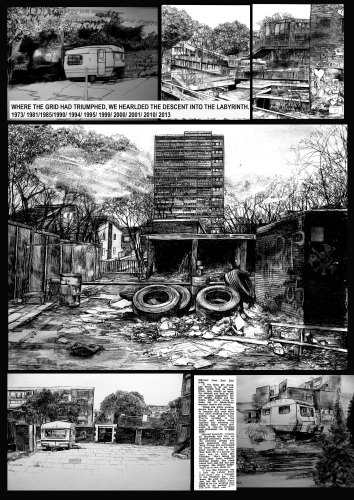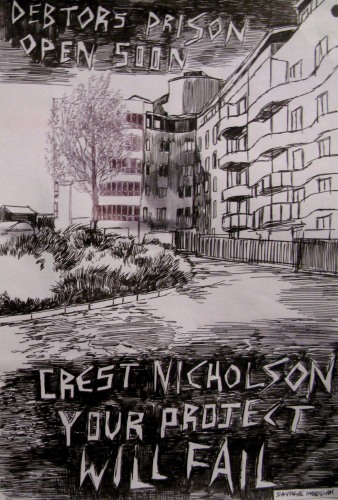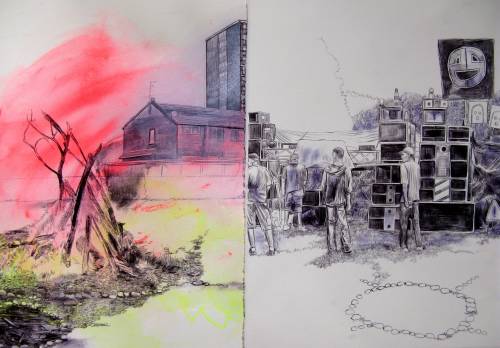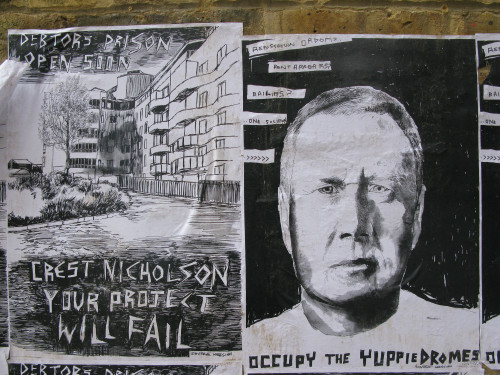Interview with Laura Oldfield Ford
Through her zine Savage Messiah, drawings and public drifts, artist Laura Oldfield Ford has recoded the urban fabric of London, bringing its repressed revenants to the fore. Josephine Berry Slater and Anthony Iles interviewed her about the varied registers of her practice and the processes of regeneration it critically chronicles.
There are many polemics against regeneration in your work. To what extent do you see regeneration as the primary object of critique in your practice?
A strident critique of regeneration has been central to my work because my zine Savage Messiah and projects related to that are about chronicling the city, about mapping the city along the contours of hidden narratives and oppositional currents. Regeneration schemes are about the remaking of the city in the cast of the bourgeoisie, about eradicating the ghosts and projecting holograms in their place. Of course in the case of London this never really works. Regeneration is not the primary object of critique but as a phenomena in the city it opens up discussions about the designing out of dissent, borders, housing and homelessness and therefore lies at the heart of any attempt to map the city along lines of social antagonism.
 Image: Laura Oldfield Ford, page from her zine Savage Messiah
Image: Laura Oldfield Ford, page from her zine Savage Messiah
You seem to explore a twin thread of both nostalgia and critique with regards to modernist monuments and ideals. Could you say something about how modernist architecture figures in your work?
The '70s was probably the last time major building of social housing took place. These projects were still relatively adherent to the Corbusian ideals of space, light and order. For me this brings into question whose order? This is something I've criticised as paternalistic, also zoning and the erasure of the chaos of the inner city street dynamic. But then I would much rather have a brand of socialist paternalism than a rampant neoliberal free for all, so there's a conflict there. Aesthetically I'm really into brutalist architecture, but it's always a brutalism that's steeped in a patina of decay and social upheaval – I'm thinking of Broadwater farm in 1985 and the Barrier Blocks in Brixton around ‘81. I like the clean lines and spaces, I'm a massive fan of Robin Hood gardens and am currently working on a project about this but I'm getting more into thinking about the individual lives, stories and hidden narratives than the smooth space of the architects plans. I'm very drawn to the non spaces or inbetween zones that were designed for free interaction. This never worked out as planned and these areas, courtyards, walkways etc. became space for the dispossessed to hang out, they became the unpoliced hidden spaces. After Broadwater farm erupted in 1985 there was a drive nationally to destroy the walkways and eradicate the warrens that were embedded in the clean modernist structures.
The work is not nostalgic in a sentimental way but more influenced by Walter Benjamin's thesis on history, about shards of messianic time hidden in the built environment waiting to be realised. Modernist architects were trying to build a better world, the construction of these buildings was an oppositional act, if you think of estates in Roehampton, the architects were trying to create a shard of some sort of utopia amidst rows of Victorian terraces. My obsession with modernist architecture, or brutalist estates in particular is not cosy or nostalgic. I want to say that this idea of a forward looking, egalitarian society has been lost and in making drawings as historical documents, I'm attempting to reactivate certain currents. I have made drawings of brutalist estates that have been demolished to make way for cul de sacs of faux Georgiana and flyposted tower blocks over the new builds.

Image: Laura Oldfield Ford, Crest Nicholson Your Project Will Fail
Your work is very much about making certain aspects of the city legible in terms of its history and possible futures. How does this work of recording lead into transformation?
Again I would refer to this Benjaminian notion of shards of messianic time, this has nothing to do with heritage. Benjamin said it's more important to avenge enslaved ancestors than make a better world for your children. In my drawings I'm trying to show how much has been erased and changed. There's a definite anger about this sense that our history been stolen, that we weren't wanted and that we don't figure in these new schemes. When I say ‘we' I suppose I mean everyone that doesn't fit into the New Labour mould of aspiring working families.
There are glimpses of class antagonism and a sense of agency attributed to the working class which forces of local government usually tend to demonise and police. Would you describe your work as amplifying these existing antagonisms, or inventing new ones?
Both ideally. I don't think working class anger can be mobilised by putting drawings in a gallery, but there are other important elements of my practice such as flyposting, making zines and putting on free events that create hubs for discussion and debate. When things start to hot up socially and politically for example, the current Visteon factory occupations [in April 2009] and the recent protests in the city, that is when the zine, collective, blog etc. become activated; that's when it plays a role in opening up channels.
Do you see yourself as a public artist? Do you consider the differing roles that constitute your practice as whole or discrete parts - e.g. self-publisher, activist, artist and so on?
No I don't. I see the term public as problematic, in the way Rosalind Deutsche problematises it. You have to ask who is the public that is being referred to? If public art was defined by the act of putting something into the public domain, then of course I would be that because I make a lot of work that operates entirely in the street. But public art, as we think of the term since the '80s, seems to be about making colonial totems that say, 'it's ok, we've tamed the natives, it's safe to come in'. My work operates on a satirical level in the sense it might act as a totem speaking to yuppies saying, 'no it's not safe to come in', because the flyposting I've done as part of the collective ‘We Are Bad' has been very direct and uncompromising.
All the disparate elements of my practice are directed from the same force, they are all manifestations of the same desire to engage with the revenants of the city and channel them into an oppositional current.

Image: Laura Oldfield Ford, Leamington Spa to Hastings
Are there any examples of recent public sculpture or community art projects you see as creating unassimilable blockages or critiques within the smooth spaces of regeneration.
Artists like Freee, Mark McGowan, Robin Bale, Plastique Fantastique and John Wild are doing work that deliberately sets out to question the populist Blairite notions of inclusivity and participation. They subvert the desire to promote the city as cultural capital by incorporating a radical agenda into their work. ‘Public' spaces or what stand in for them, so shopping malls, town squares etc. with Starbucks and high street chains are their favoured arenas, these are the places set up ostensibly to facilitate free interaction but are solely designed for consumption and any behaviour that resembles anything beyond that is immediately pounced upon as criminal. So they set up situations where they assemble and do things that involve participation and inclusion with the intention of attacking New labour ideas of participation and inclusion or by extension Nicolas Bourriaud's idea of this.
The form of any art work can be recuperated. Think of the Reclaim the Streets tactic of converging on a space and disrupting normal relations with it and how that became a sanitized version with the flash mobs and then ended up as some flimsy mobile phone advert featuring hordes of synchronized dancers in Liverpool street. But the idea itself, the kernel of that project cannot be recuperated, instead it mutates and cloaks itself in other forms.
If the aestheticisation of space relates to modalities of power, what do current urban aestheticisation programmes reveal about contemporary forms of power?
There's an obsession with friendly looking architecture, curved lines, outgrowths of green roof tops, panels and balconies in Scandinavian wood or brightly coloured aluminium. Again this refers back to this idea of inclusion, everything being friendly but readable. As power becomes more oppressive it pretends to be more consensual. Dole offices have ditched the metal grilles and instead have orange fabric settees and teams of roving security guards. There's this playschool architecture everywhere, it acts as a frame and a decoy, as if in the '90s all battles were won.

Image: Laura Oldfield Ford, Crest Nicholson Your Project Will Fail, Occupy the Yuppie Dromes, flyposters
How do artists work with the biopolitical imperative to create and market an entrepreneurial self?
Working within the structures of a gallery system is by definition entrepreneurial, it depends how you problematise that in your work, I'm not sure whether you can argue making images that are uncomfortable to the galleries constituency equates with autonomy.
I have worked and continue to work in a range of spaces from commercial gallery to publicly funded institutions to social spaces as well as outside of all of these. For me it would be limiting to confine myself to showing in one particular environment. I think it suits my work better to have a fluidity in the way I'm represented. I am aware of how artists have been used to further the aims of the gentrifiers, the mere presence of artists in an area can do that. But the role of the artist becomes something else when the gallery system crashes and the social terrain starts to shift radically. There will be a whole load of people who did art degrees to get into the ‘creative industries' with the aim of making a lot of easy money who'll just disappear and that will be a good thing
Laura Oldfield Ford <savagemessiah AT hotmail.co.uk> is an artist based in London
Mute Books Orders
For Mute Books distribution contact Anagram Books
contact@anagrambooks.com
For online purchases visit anagrambooks.com






